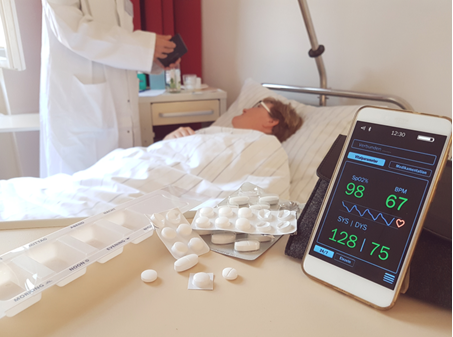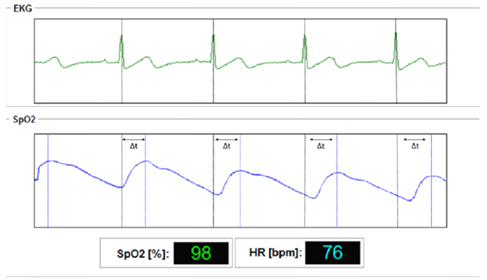
COntinuous, Mobile, MUltisensory, Non Invasive Controlling and processing of data on blood pressure, oxygen saturation, pulse, and movement to guide individualized care and treatment and medication management for Patients in need of care.
Motivation
Specific challenges must be taken into account in the medical care of persons in need of long-term care. In addition, the number of geriatric individuals in need of care will increase in the coming years, and at the same time, fewer and fewer people will be available informally or professionally to provide care and support to these individuals. Many of these patients will receive extensive multimedication regimens, the side effects and interactions of which can have a high impact on cardio-pulmonary performance. For this reason, new technologies must be used to improve care and minimize risks. Mobile health monitoring can support this in a continuous and non-invasive way.

Objective and procedure
In the KOMMUNIKAP project, a non-invasive monitoring system is being developed that records the oxygen saturation, blood pressure, pulse and movement of care recipients. For this purpose, inconspicuous sensors close to the body are used to analyze the recorded data with regard to typical problems in care recipients (e.g. bedsores or respiratory diseases) and to process the data for those providing treatment. The integration of various vital parameters and movement data enables early therapeutic intervention. All information of the system is available for direct or telemedical information exchange with the therapeutic team, if required, in order to inform or be informed comprehensively about the respective state of health.
The company PAR Medizintechnik is to develop a system platform for pulse-resolved blood pressure measurement based on its many years of experience in the development and approval of medical products. This is to be realized by means of a compact sensor system to be worn close to the chest.
A challenge in this project is the derivation, processing and analysis of biosignals for pulse-resolved blood pressure measurement. The devices currently available on the market from the company PAR Medizintechnik process and analyze the pressure pulse that is transmitted from the blood-bearing vessel via a blood pressure cuff to the pressure transducer. For the new method of continuous determination of blood pressure to be developed, an optical signal in the form of a photoplethysmogram is required, which represents the volume pulse. For this reason, the development of new suitable algorithms for the determination of blood pressure from volume data is necessary.
Furthermore, the monitoring device should be designed as a "smart patch", which is attached to the chest of the patient. For this purpose, suitable fastening methods have to be developed and a design has to be achieved that allows the patient a pleasant daily comfort.
Innovations and perspectives
Precise, rapid intervention improves care services, identifies possible long-term damage at an early stage and reduces the number of inpatient stays. Since care recipients remain mobile during monitoring, the system also supports home care.
By using KOMMUNIKAP, changes in the health status of care recipients can be detected promptly even beyond predefined contexts and treated if necessary. In the case of persons usually affected by multimedication, dangerous health-relevant side effects and interactions can thus be detected and long-term damage to health avoided.
In contrast to the pulse-resolved blood pressure measurement envisaged in the project, the classic oscillometric blood pressure measurement is carried out externally on the upper arm or wrist and causes considerable discomfort for patients, especially during 24-hour monitoring, where a measurement is carried out every 15 minutes. The tension of frequent measurements and restless nighttime sleep can lead to measurement inaccuracies, among other things. Pulse-resolved blood pressure measurement allows the detection of short blood pressure fluctuations that cannot be detected by conventional interval measurements. Such blood pressure spikes are caused, for example, by prescription drugs such as corticosteriods or asthma medications, but kidney diseases or hormone disorders also initiate these short spikes. In the long run and without treatment, such short incidents cause damage to the cardiovascular system, eyes and internal organs. The method for pulse-resolved blood pressure measurement is based on the fact that blood is ejected into the arteries by the heartbeat and then the blood pressure wave reaches the periphery, which is detected optically. This pulse transfer time (PTT) is, among other things, indirectly proportional to the stiffness of the arterial vessels. All factors that influence the pulse wave velocity (PWV) thus also directly change the PTT. Along with muscle tension, stiffness is one of the most important factors influencing PWV. PTT also shows indirect proportionality to blood pressure. The main factors determining PTT are blood pressure, muscle tone, and compliance (stiffness) of the arteries. These lead to a decrease in PTT due to increased PWG. The increase in intrathoracic pressure during inspiration leads to a decrease in blood pressure and thus an increase in PTT. By determining PTT, acute changes in blood pressure can be adequately monitored. The relationship between PTT and blood pressure has been mentioned several times in the literature in the 1970s, and the current patent situation does not stand in the way of the development of a new sensor system.

In order to realize a non-invasive pulse-resolved blood pressure measurement, a device is to be developed which can be worn close to the body and which allows the recording of an electrocardiogram and a plethysmogram. The device should be very compact and be attached close to the chest. The electrodes will be designed as disposable articles for hygienic reasons. On the outside, the device will resemble a larger patch and share data with the KOMMUNIKAP system via Bluetooth Low Energy. Such a concept of a "smart patch" for the determination of pulse-resolved blood pressure does not exist yet.